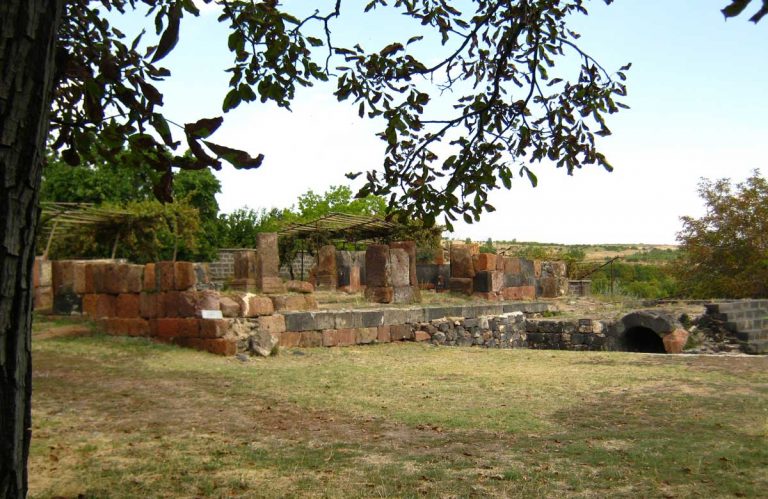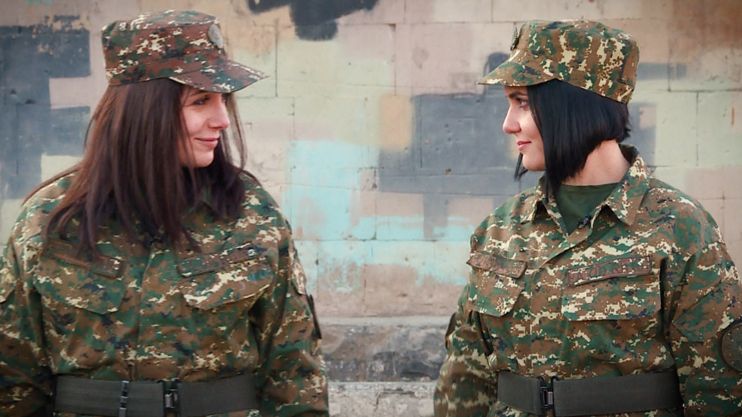
The roles of men and women in early medieval Armenia were primarily guided by the tenets of awrēnk, which functioned as an unwritten customary law, judging Armenians by their righteous (awrēnk) and unrighteous (anawrēn) behavior.
By Lewis Read
During the 2020 Nagorno-Karabakh war, the Republic of Armenia established its first all-women military detachment. This was the latest in a series of developments that won women the right to serve in the Armenian armed forces since military academies first opened their doors to them in 2013. The unit was named the Erato Detachment, after a first-century Armenian queen. The inclusion of historical women in modern Armenian discourse is a relatively new and rare phenomenon and it is in large part the product of work within the field of Armenian studies over the past few years. The absence of historical female figures can ultimately be traced to the ways in which they were represented in the earliest Armenian historical narratives, which continue to play an important role in the collective Armenian memory.
P‘aranjem, the fourth-century warrior queen, is a complex and enigmatic figure in early Armenian history. A case study of the way in which her story has been recorded provides a perfect example of how some texts marginalize women from the past. While there is a brilliant range of early medieval Armenian literature, it is conditioned by traditional social constraints. The sources are, for example, primarily interested in the nobility (the naxarars), meaning our view of early Armenia is seen through a largely male and elite gaze. But some texts, such as Buzandaran Patmut‘iwnk‘, an anonymous history of the Kingdom of Armenia from AD 330 until its decline and partition in 387, contain the stories of figures such as P‘aranjem.
The roles of men and women in early medieval Armenia were primarily guided by the tenets of awrēnk, which functioned as an unwritten customary law, judging Armenians by their righteous (awrēnk) and unrighteous (anawrēn) behaviour. After the kingdom’s conversion in the early fourth century, these moralizing ideals were underpinned by Christian ethics. For Armenian women this was rooted in religious models of obedience, chastity and modesty, while men were valued for their martial ability, leadership and heroism. Awrēnk also linked women to the household, certain religious settings and education, whereas men engaged in politics and the legal leadership of the family unit. Those who conformed to traditional roles were praised, but those who transgressed were criticized. Awrēnk was undoubtedly subject to change over time and it is difficult to determine how much bearing it had on everyday life, but it was clearly used by historical writers to frame conformity and transgression. The story of P‘aranjem, a woman who challenged and subverted a number of these expectations, illustrates just how much of an influence awrēnk could have on how a person was written about and remembered.
We are first introduced to P‘aranjem in Buzandaran during the reign of Aršak II of Armenia (AD 350-367/8). The daughter of the lord of Siwnik, P‘aranjem was ‘renowned for her beauty and modesty’ and became the wife of Gnel, the king’s nephew. P‘aranjem’s portrayal is critical of her beauty. According to Buzandaran, as the fame of her ‘loveliness’ grew, Gnel’s cousin, Tirit’, became obsessed with her. Filled with longing, Tirit’ slandered Gnel to Aršak, who was eventually convinced to order Gnel’s execution. Despite the murderous actions being conceived of and carried out by men, it is P‘aranjem who gets the blame. Upon learning of his execution, she exclaims ‘my husband’s death was because of me, my husband was put to death because someone desired me!’ In the eyes of the compiler, P‘aranjem had roused the dangers of carnal desire. Through no fault of her own, her appearance became a dangerous force.

Aršak subsequently took P‘aranjem as his wife, but she repeatedly spurned her new husband because he was ‘hairy of body’. This rejection marks a turning point. She is suddenly cast as anawrēn – unrighteous – and is subjected to a pointed character assassination. In response, Aršak took a second wife, Olympias. Driven by apparent jealousy, P‘aranjem had her rival murdered. This is a striking change of character: from disconsolate mourner to scheming murderer all within a matter of paragraphs. This somewhat strange switch may well be a product of the moralizing tendencies of the compiler. P‘aranjem’s story is used as an example for those who might transgress awrēnk. She had refused to comply with her husband’s wishes and such unrighteous behavior could only be followed by evil actions.
It is the last part of P‘aranjem’s story which is the most remarkable, though. In the context of an ongoing war with Sasanian Persia, Aršak was captured and imprisoned and P‘aranjem, now referred to as the Queen of Armenia, assumed the leadership of the kingdom. According to Buzandaran, she led 11,000 men in a defence against the Sasanians. Besieged in the fortress of Artagers, P‘aranjem held out for 14 months, enduring epidemic and insurmountable odds. Eventually she was forced to surrender, the fortress was captured and P‘aranjem was taken to Persia where she was killed.
These dramatic events proved a challenge for the compiler of Buzandaran. P‘aranjem had displayed brave leadership, but in so doing she had subverted the expectations of awrēnk. While the compiler praises men for similar acts, exhorting their valour at length, P‘aranjem does not receive the same affirmation. In fact, her actions are not subject to any evaluation and the epic siege is briefly recorded without praise.
The compiler even incorporated a member of the garrison into the narrative to verbally attack the queen. He admonishes the failed rule of the Armenian royal dynasty, telling P‘aranjem that ‘justly, all of this has come on you’. This suggests a woman’s agency outside of her prescribed roles – even in the most exceptional circumstances – was rarely valued or acknowledged. The text cannot, however, change the fact that P‘aranjem had led the kingdom and sacrificed herself for Armenia. This seems to have confused the compiler, who could not find a simple way to categorize her actions. In any case, P‘aranjem had already been classified as anawrēn, which made her irredeemable. As a consequence, her bravery was unacknowledged and she alone was blamed for the failings of an entire dynasty.
The story of P‘aranjem is both fascinating and frustrating. She displayed bravery and leadership, but she was scrutinized and then shamed for challenging and subverting the prescribed roles of a woman as stipulated by awrēnk. Despite her significant place in early Armenian history, P‘aranjem’s treatment has left her largely absent from current discussions of Armenia’s past. Her story highlights the need for further research on the history of women and their representation in Armenia in order to explain why their past treatment has led to their continued marginalization.
_____________________